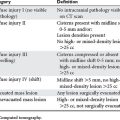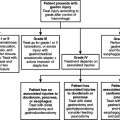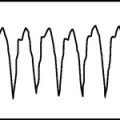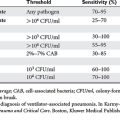CHAPTER 100 DIAGNOSIS AND TREATMENT OF DEEP VENOUS THROMBOSIS: DRUGS AND FILTERS
The association between injury and venous thromboembolic events is well accepted in trauma patients. The incidence in deep venous thrombosis varies from 7% to 58% depending on the demographics of the patients, nature of the injuries, method of detection, and the type and timing of prophylaxis used in the study population.1–4 It is thought that the high incidence of deep venous thrombosis in the trauma population can be attributed to the altered physiologic states and anatomic derangements that often coexist in these patients. Virchow’s triad of stasis, vessel injury, and hypercoagulability often are present in these patients. Venous stasis is promoted by prolonged bed rest, patient immobilization, paralysis, and hypoperfusion, none of which are uncommon in trauma patients. In addition, hypercoagulability may be induced by diminished levels of antithrombin III, suppression of fibrinolysis, or other alterations in the coagulation system. Finally, the presence of endothelial damage, caused by direct vascular injury, can result in intimal damage and eventually thrombus.
Prevention of thromboembolic events in patients that are simultaneously at high risk for deep venous thrombosis (DVT) formation and bleeding poses a difficult challenge to the trauma surgeon. This challenge is compounded by the fact that more than 60% of DVTs are clinically occult.5,6 The usual signs and symptoms of DVT, such as swelling and pain, are often obscured by injury.
Many studies have been completed in an attempt to stratify trauma patients into high-risk subgroups for the development of DVT. Traditionally, pelvic and lower extremity fractures, head injury, and prolonged immobilization are considered critical risk factors for DVT formation.1,2,4,7,8 In addition, large volume blood transfusions raise the likelihood of DVT. Current evidence clearly implicates spinal cord injury and spinal fractures as high-risk conditions.9 Older age also predisposes to thrombosis, although the exact transition point is unclear.10–12 Other factors that may also place patients at a higher risk for DVT development, but are not well studied or agreed upon, include injury severity score (ISS) and large transfusion volume.
SEQUENTIAL COMPRESSION DEVICES
The use of sequential compression devices (SCD) is attractive because of the low complication rate associated with their use. However, with the exception of head injured patients, SCDs have been shown to offer little benefit over no specific prophylaxis.13 Problems with mechanical compression devices in trauma patients are accessibility and compliance. Many trauma patients require casting or external fixation limiting accessibility to the lower extremity, making use of mechanical compression devices difficult or impossible. Shackford et al.7 noted that venous compression devices could not be placed at all in 35% of trauma patients because of traction, edema, external fixators, or casts. Lack of compliance is a major contributing factor in the failure of mechanical compression devices in trauma patients. Given the short-lived antithrombotic effect of SCD, even limited periods of noncompliance may encourage clot formation.7,14 In a prospective study of 227 patients, only 19% were fully compliant with physician orders for SCD prophylaxis.15 Venous foot pumps, once thought of as a substitute for SCD in situations in which the calves were inaccessible, have been shown to be insufficient prophylaxis.
LOW-DOSE HEPARIN
In the general surgery population, low-dose heparin decreases the rate of DVT formation. Although the low rate of bleeding complications associated with the use of low-dose heparin would make it well suited for use in trauma, several studies reveal low-dose heparin to be relatively ineffective in preventing DVT in the subset of higher-risk trauma patients.16–18
LOW-MOLECULAR-WEIGHT HEPARIN
Low-molecular-weight heparin (LMWH) gained popularity in the late 1990s as an effective method of DVT prophylaxis in trauma patients. In a randomized double-blinded trial comparing LMWH to low-dose heparin in trauma patients, LMWH reduced the overall DVT rate by 30%, although both groups had a high incidence of DVT formation.17 Subsequent clinical evaluations and recent guidelines support the safety and efficacy of enoxaparin in trauma patients who do not have substantial bleeding risk.16,19–23 Clinical experience with other LMWH is increasing in the trauma population. A single-center evaluation of 743 high-risk trauma patients who received dalteparin 5000 IU SQ daily reported rates of proximal DVT and nonfatal PE as 3.9% and 0.8%, with a corresponding 3% rate of significant bleeding.24 Preliminary data in spinal cord injury suggest that dalteparin 5000 IU daily and enoxaparin 30 mg twice daily have comparable bleeding risks while providing similar protection from DVT.25 Caution is necessary in extrapolating therapeutic equivalence among LMWH agents, due to differences in dose equivalences, pharmacokinetics, administration times and DVT/PE diagnosis used in clinical trials.
INFERIOR VENA CAVA FILTERS
Trauma patients are often not candidates for adequate pharmacologic prophylaxis or therapeutic anticoagulation when a DVT is documented. These patients may, however, be candidates for the placement of an inferior vena cava filter. Currently there are no randomized and very few prospective studies on the use and long-term outcomes of inferior vena cava filters (IVC filters). IVC filters do not prevent DVT formation. They are intended to reduce the risk of pulmonary embolism (PE), and specifically, fatal pulmonary embolism. It should be noted that this has not been consistently proven, especially when used prophylactically. Some, in fact, argue that IVC filters actually promote DVT formation and may result in caval thrombosis and the long-term postphlebitic syndrome.26–28 Other authors report a decrease in the incidence of pulmonary embolism versus historical controls. Still others cite no change in the incidence of pulmonary embolism, persistence of morbidity from DVT, or long-term outcomes. Filter complications include migration, tilt, caval perforation, and PE.26,29–33 In 2002, the Eastern Association for the Surgery of Trauma published its practice management guidelines for the prevention of venous thromboembolism in trauma patients. Although there were no class I data to support prophylactic vena cava filter placement in high-risk trauma patients, there was a reasonable amount of retrospective and case series data to support the recommendation for consideration of prophylactic vena cava filter insertion in high-risk patients who cannot receive anticoagulation.22 DVT formation in the trauma patient is theorized to result from local effects of the inflammatory response in combination with venous stasis. The at-risk period in these patients is relatively short and well-defined, making the use of permanent vena cava filters, with their associated risks, less appealing. Retrievable vena cava filters, on the other hand, are thought to offer the same protection as permanent filters during the period of greatest risk, while later retrieval might avoid long-term risk.34,35 Although several filters have the indication for temporary use and, therefore, would be appropriate in trauma patients, recent literature shows a significant number of “temporary filters” are not retrieved for reasons including lack of follow-up by patients, technical difficulty, and ongoing risk that exceed the time window for filter removal.36–39 There are also concerns about embolization and the need for anticoagulation during retrieval of temporary IVC filters, which may outweigh the benefit that these temporary filters provide.
SURVEILLANCE
The diagnosis of DVT or PE in the trauma population is plagued by the insidious onset, frequent lack of clinical signs or symptoms, and nonspecific presentation. Physical examination is unreliable and insufficient.39 Several studies of DVT surveillance assert an overwhelming number of asymptomatic DVTs in trauma patients. Duplex scanning, which combines ultrasound imaging with Doppler measurement of flow velocity, is now the most commonly used method to detect DVT formation. It has been shown to have an 89%–100% sensitivity and specificity comparable to traditional lower extremity venography.40 This bed-side procedure can be performed easily and repeatedly.5,41,42 Lower extremity fixators or casts limit or prohibit visualization of the pelvic veins. Several studies have cast some doubt on the routine use of duplex surveillance, while others advocate its use in high-risk patients, particularly those with spinal cord and/or major pelvic/lower extremity orthopedic injuries.43–49 Arguments against routine screening include the low clinical yield, minimal reduction in PE incidence, and a relatively high cost associated with serial scanning.49–51 Perhaps strict evidence-based protocols for DVT prophylaxis, centered on risk stratification, are better at reducing the incidence and complication of DVTs than routine screening.
RECOMMENDATION
Prophylactic therapy for DVT formation in high-risk trauma patients needs to be individualized, weighing the potential risks and benefits of each intervention. It is generally accepted that low-dose heparin has no role in this patient population. SCDs, although they have not been shown to have a significant, or even any, benefit in this patient population, are essentially risk-free. The largest hurdle to the routine use of SCDs is access and compliance. Although we are limited in cases of lower extremity injuries, compliance can be improved with education for both health care providers and patients. When anticoagulation is reasonably safe, therapy with LMWH should be implemented as soon as feasible. A recent multicenter prospective cohort study of multi-injured patients, prophylaxis was initiated within 48 hours of injury in only 25% of patients and another one-quarter had no prophylaxis for at least 7 days. Furthermore, a delay in initiation of prophylaxis of more than 4 days resulted in a 300% higher risk of venous thromboembolism.52 Thus, in high-risk patients who cannot be safely anticoagulated, the placement of an inferior vena cava filter for prophylaxis must be carefully considered early in the patient’s hospital course.
1 Knudson MM, Collins JA, Goodman SB, et al. Thromboembolism following multiple trauma. J Trauma. 1992;32:2-11.
2 Knudson MM, Lewis FR, Clinton A, et al. Prevention of venous thromboembolism in trauma patients. J Trauma. 1994;37:480-487.
3 Rogers FB. Venous thromboembolism in trauma patients: a review. Surgery. 2001;130:1-12.
4 Geerts WH, Code KI, Jay RM, et al. A prospective study of venous thromboembolism after major trauma. N Engl J Med. 1994;331:1601-1606.
5 Napolitano LM, Garlapati VS, Heard SO, et al. Asymptomatic deep venous thrombosis in the trauma patient: is an aggressive screening protocol justified? J Trauma. 1995;39:651-657. discussion 657–659
6 Gearhart MM, Luchette FA, Proctor MC, et al. The risk assessment profile score identifies trauma patients at risk for deep vein thrombosis. Surgery. 2000;128:631-640.
7 Shackford SR, Davis JW, Hollingsworth-Fridlund P, et al. Venous thromboembolism in patients with major trauma. Am J Surg. 1990;159:365-369.
8 Knudson MM, Ikossi DG. Venous thromboembolism after trauma. Current opinion in critical care. 2004;10:539-548.
9 Velmahos GC, Kern J, Chan LS, et al. Prevention of venous thromboembolism after injury: an evidence-based report—part II: analysis of risk factors and evaluation of the role of vena caval filters. J Trauma. 2000;49:140-144.
10 Abelseth G, Buckley RE, Pineo GE, et al. Incidence of deep-vein thrombosis in patients with fractures of the lower extremity distal to the hip. J Orthop Trauma. 1996;10:230-235.
11 Spannagel U, Kujath P. Low molecular weight heparin for the prevention of thromboembolism in outpatients immobilized by plaster cast. Semin Thromb Hemost. 1993;19(Suppl 1):131-141.
12 Schultz DJ, Brasel KJ, Washington L, et al. Incidence of asymptomatic pulmonary embolism in moderately to severely injured trauma patients. J Trauma. 2004;56:727-731. discussion 731–723
13 Fisher CG, Blachut PA, Salvian AJ, et al. Effectiveness of pneumatic leg compression devices for the prevention of thromboembolic disease in orthopaedic trauma patients: a prospective, randomized study of compression alone versus no prophylaxis. J Orthop Trauma. 1995;9:1-7.
14 Jacobs DG, Piotrowski JJ, Hoppensteadt DA, et al. Hemodynamic and fibrinolytic consequences of intermittent pneumatic compression: preliminary results. J Trauma. 1996;40:710-716. discussion 716–717
15 Cornwell EE3rd, Chang D, Velmahos G, et al. Compliance with sequential compression device prophylaxis in at-risk trauma patients: a prospective analysis. Am Surg. 2002;68:470-473.
16 Knudson MM, Morabito D, Paiement GD, et al. Use of low molecular weight heparin in preventing thromboembolism in trauma patients. J Trauma. 1996;41:446-459.
17 Geerts WH, Jay RM, Code KI, et al. A comparison of low-dose heparin with low-molecular-weight heparin as prophylaxis against venous thromboembolism after major trauma. N Engl J Med. 1996;335:701-707.
18 Mammen EF. Pathogenesis of venous thrombosis. Chest. 1992;102:640S-644S.
19 Greenfield LJ, Proctor MC, Rodriguez JL, et al. Posttrauma thromboembolism prophylaxis. J Trauma. 1997;42:100-103.
20 Norwood SH, McAuley CE, Berne JD, et al. Prospective evaluation of the safety of enoxaparin prophylaxis for venous thromboembolism in patients with intracranial hemorrhagic injuries. Arch Surg. 2002;137:696-701. discussion 701–692
21 Norwood SH, McAuley CE, Berne JD, et al. A potentially expanded role for enoxaparin in preventing venous thromboembolism in high risk blunt trauma patients. J Am Coll Surg. 2001;192:161-167.
22 Rogers FB, Cipolle MD, Velmahos G, et al. Practice management guidelines for the prevention of venous thromboembolism in trauma patients: the EAST practice management guidelines work group. J Trauma. 2002;53:142-164.
23 Ginzburg E, Cohn SM, Lopez J, et al. Randomized clinical trial of intermittent pneumatic compression and low molecular weight heparin in trauma. Br J Surg. 2003;90:1338-1344.
24 Cothren CC, Smith WR, Moore EE, et al. Utility of once-daily dose of low-molecular-weight heparin to prevent venous thromboembolism in multisystem trauma patients. World J Surg. 2007;31:98-104.
25 Chiou-Tan FY, Garza H, Chan KT, et al. Comparison of dalteparin and enoxaparin for deep venous thrombosis prophylaxis in patients with spinal cord injury. Am J Phys Med Rehab. 2003;82:678-685.
26 Rodriguez JL, Lopez JM, Proctor MC, et al. Early placement of prophylactic vena caval filters in injured patients at high risk for pulmonary embolism. J Trauma. 1996;40:797-802. discussion 802–794
27 Patton JHJr, Fabian TC, Croce MA, et al. Prophylactic Greenfield filters: acute complications and long-term follow-up. J Trauma. 1996;41:231-236. discussion 236–237
28 Decousus H, Leizorovicz A, Parent F, et al. A clinical trial of vena caval filters in the prevention of pulmonary embolism in patients with proximal deep-vein thrombosis. Prevention du Risque d’Embolie Pulmonaire par Interruption Cave Study Group. N Engl J Med. 1998;338:409-415.
29 Kinney TB. Update on inferior vena cava filters. J Vasc Interv Radiol. 2003;14:425-440.
30 McMurtry AL, Owings JT, Anderson JT, et al. Increased use of prophylactic vena cava filters in trauma patients failed to decrease overall incidence of pulmonary embolism. J Am Coll Surg. 1999;189:314-320.
31 Gosin JS, Graham AM, Ciocca RG, et al. Efficacy of prophylactic vena cava filters in high-risk trauma patients. Ann Vasc Surg. 1997;11:100-105.
32 Carlin AM, Tyburski JG, Wilson RF, et al. Prophylactic and therapeutic inferior vena cava filters to prevent pulmonary emboli in trauma patients. Arch Surg. 2002;137:521-525. discussion 525–527
33 Bochicchio GV, Scalea TM. Acute caval perforation by an inferior vena cava filter in a multitrauma patient: hemostatic control with a new surgical hemostat. J Trauma. 2001;51:991-992. discussion 993
34 Rosenthal D, Wellons ED, Lai KM, et al. Retrievable inferior vena cava filters: initial clinical results. Ann Vasc Surg. 2006;20:157-165.
35 Johns JS, Nguyen C, Sing RF. Vena cava filters in spinal cord injuries: evolving technology. The journal of spinal cord medicine. 2006;29:183-190.
36 Kirilcuk NN, Herget EJ, Dicker RA, et al. Are temporary inferior vena cava filters really temporary? Am J Surg. 2005;190:858-863.
37 Antevil JL, Sise MJ, Sack DI, et al. Retrievable vena cava filters for preventing pulmonary embolism in trauma patients: a cautionary tale. J Trauma. 2006;60:35-40.
38 Hoff WS, Hoey BA, Wainwright GA, et al. Early experience with retrievable inferior vena cava filters in high-risk trauma patients. J Am Coll Surg. 2004;199:869-874.
39 Karmy-Jones R, Jurkovich GJ, Velmahos GC, et al. Practice patterns and outcomes of retrievable vena cava filters in trauma patients: an AAST multicenter study. J Trauma. 2007;62:17-24. discussion 24–15
40 Hammers LW, Cohn SM, Brown JM, et al. Doppler color flow imaging surveillance of deep vein thrombosis in high-risk trauma patients. J Ultrasound Med. 1996;15:19-24.
41 Wibbenmeyer LA, Hoballah JJ, Amelon MJ, et al. The prevalence of venous thromboembolism of the lower extremity among thermally injured patients determined by duplex sonography. J Trauma. 2003;55:1162-1167.
42 Burns GA, Cohn SM, Frumento RJ, et al. Prospective ultrasound evaluation of venous thrombosis in high-risk trauma patients. J Trauma. 1993;35:405-408.
43 Velmahos GC, Nigro J, Tatevossian R, et al. Inability of an aggressive policy of thromboprophylaxis to prevent deep venous thrombosis (DVT) in critically injured patients: are current methods of DVT prophylaxis insufficient? J Am Coll Surg. 1998;187:529-533.
44 Gathof BS, Picker SM, Rojo J. Epidemiology, etiology and diagnosis of venous thrombosis. Eur J Med Res. 2004;9:95-103.
45 Kadyan V, Clinchot DM, Colachis SC. Cost-effectiveness of duplex ultrasound surveillance in spinal cord injury. Am J Phys Med Rehab. 2004;83:191-197.
46 Liu LT, Ma BT. Prophylaxis against venous thromboembolism in orthopedic surgery. Chin J Traumatol. 2006;9:249-256.
47 Hums W, Blostein P. A comparative approach to deep vein thrombosis risk assessment. J Trauma Nurs. 2006;13:28-30.
48 Borer DS, Starr AJ, Reinert CM, et al. The effect of screening for deep vein thrombosis on the prevalence of pulmonary embolism in patients with fractures of the pelvis or acetabulum: a review of 973 patients. J Orthop Trauma. 2005;19:92-95.
49 Piotrowski JJ, Alexander JJ, Brandt CP, et al. Is deep vein thrombosis surveillance warranted in high-risk trauma patients? Am J Surg. 1996;172:210-213.
50 Spain DA, Richardson JD, Polk HCJr, et al. Venous thromboembolism in the high-risk trauma patient: do risks justify aggressive screening and prophylaxis? J Trauma. 1997;42:463-467. discussion 467–469
51 Stawicki SP, Grossman MD, Cipolla J, et al. Deep venous thrombosis and pulmonary embolism in trauma patients: an overstatement of the problem? Am Surg. 2005;71:387-391.
52 Nathens AB, McMurray MK, Cuschieri J, et al. The practice of venous thromboembolism prophylaxis in the major trauma patient. J Trauma. 2007;62:557-562. discussion 562–553






